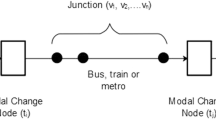Abstract
The planning of transit services is vital to transit-oriented metropolises. It is a complex, multi-objective decision process, especially for services operated by the private sector. Traveler’s desire for direct, affordable, and quality services often conflicts with the profit-making objective of private operators. In a multi-modal network, partly collaborative and partly competitive interactions among transit modes further complicate the problem. To simplify the planning problem, existing studies generally consider transit network design from the perspective of a single mode while neglecting the modal interactions. The lack of a comprehensive approach across transit modes may result in an unbalanced supply of transit services, weakening the financial viability of the services and, more importantly, adding unnecessarily to congestion, especially in already congested districts. This study explicitly considers these interactions in a multi-modal network framework. We develop a systematic phase-wise methodology for multi-modal network design, considering both the effect of congestion and integration of modal transfers. Inter-route and inter-modal transfers are modeled through the State Augmented Multi-modal (SAM) network approach developed in earlier studies. An illustrative example is included to demonstrate the design procedure and its salient features.
Similar content being viewed by others
References
Baaj MH, Mahmassani HS (1995) Hybrid route generation heuristic algorithm for the design of transit networks. Transp Res Part C 3:31–50
Bard JF (1998) Practical bilevel optimization: algorithms and applications. Kluwer Academic, Dordrecht
Ben-Akiva M, Lerman SR (1985) Discrete choice analysis: theory and application to travel demand. MIT Press, Cambridge
Bruno G, Ghiani G, Improt G (1998) A multi-modal approach to the location of a rapid transit line. Eur J Oper Res 104:321–332
Ceder A, Wilson NHM (1986) Bus network design. Transp Res Part B 20:331–344
Colson B, Marcotte P, Savard G (2005) Bilevel programming: a survey. Q J Oper Res 3:87–107
Dufourd H, Gendreau M, Laporte G (1996) Locating a transit line using tabu search. Locat Sci 4:1–19
Lo HK, Yip CW, Wan KH (2003a) Modeling transfer and nonlinear fare structure in multi-modal network. Transp Res Part B 37:149–170
Lo HK, Yip CW, Wan QK (2003b) Modeling competitive multi-modal transit services. In: Lam WHK, Bell MGH (eds) Advanced modeling for transit operations and service planning. Pergamon, Amsterdam, pp 231–256
Lo HK, Yip CW, Wan QK (2004) Modeling competitive multi-modal transit services: a nested logit approach. Transp Res Part C 12:251–272
Magnanti TL, Wong RT (1984) Network design and transportation planning: models and algorithms. Transp Sci 18:1–55
Mas-Colell A, Whinston MD, Green JR (1995) Microeconomic theory. Oxford University Press, New York
Michaelis M, Schöbel A (2009, to appear) Integrating line planning, timetabling, and vehicle scheduling: a customer-oriented heuristic. Public Transp. doi:10.1007/s12469-009-0014-9
Nielsen OA (2000) A stochastic transit assignment model considering differences in passengers utility functions. Transp Res Part B 34:377–402
Pattnaik SB, Mohan S, Tom VM (1998) Urban bus transit route network design using genetic algorithm. J Transp Eng 124:368–375
Rea JC (1971) Designing urban transit systems: An approach to the route-technology selection problem. Report no. UMTA-URT-49(70)-71-6 by the Urban Transportation Program, University of Washington, Seattle, WA
Wan QK, Lo HK (2003) A mixed integer formulation for multiple-route transit network design. J Math Model Algorithms 2:299–308
Author information
Authors and Affiliations
Corresponding author
Rights and permissions
About this article
Cite this article
Wan, Q.K., Lo, H.K. Congested multimodal transit network design. Public Transp 1, 233–251 (2009). https://doi.org/10.1007/s12469-009-0015-8
Published:
Issue Date:
DOI: https://doi.org/10.1007/s12469-009-0015-8




